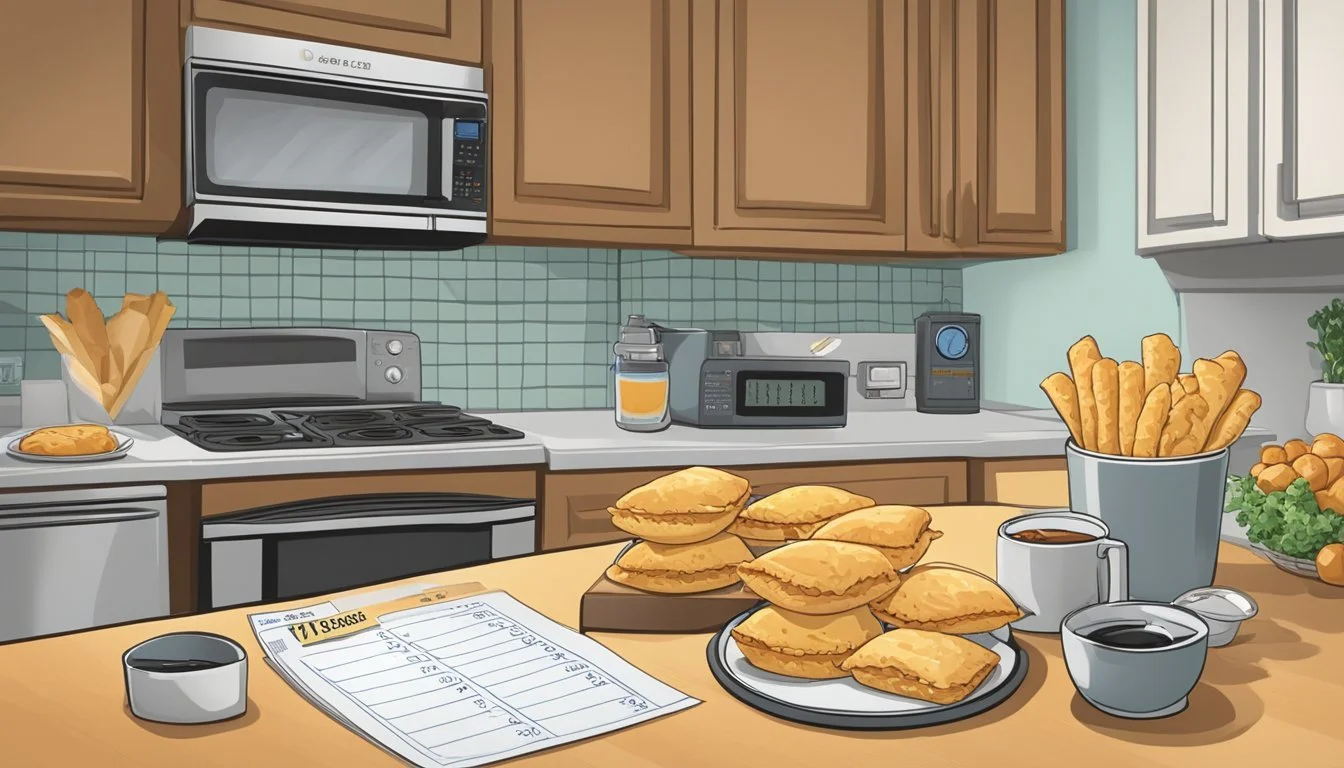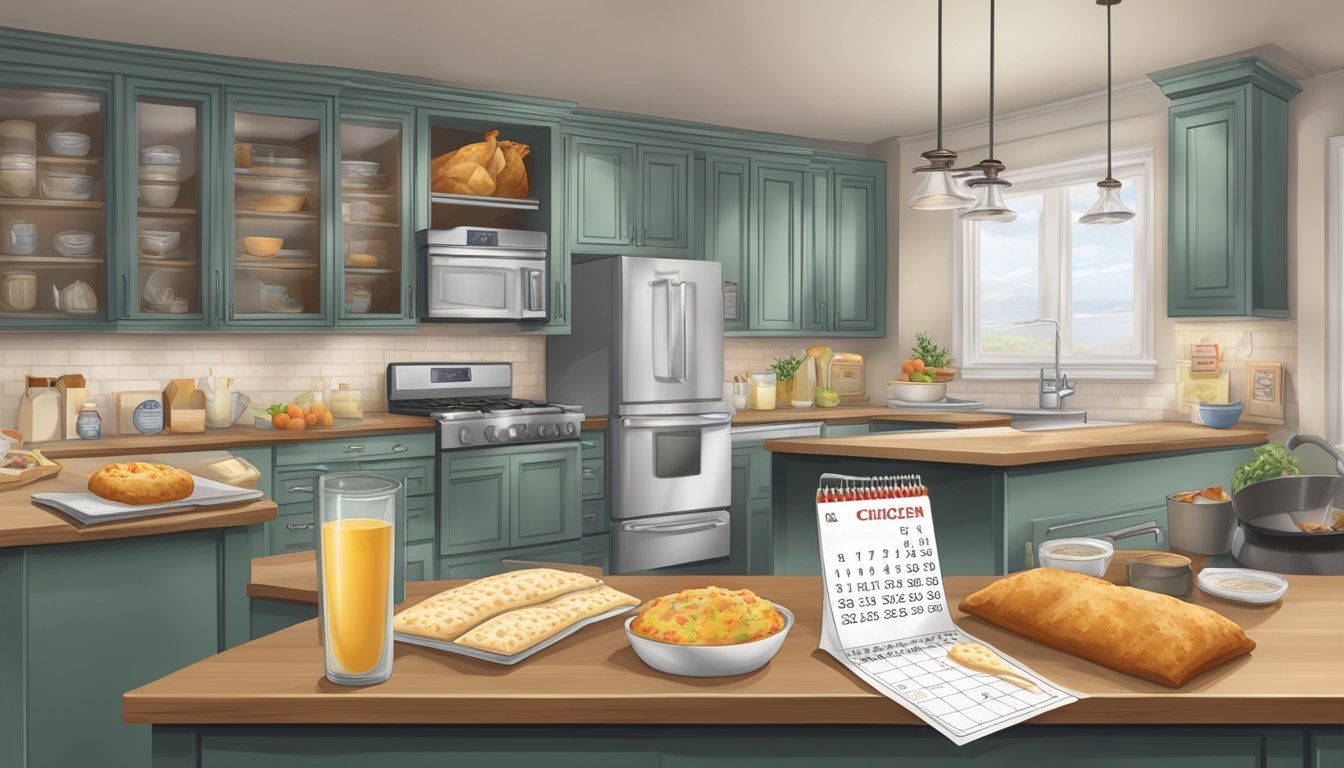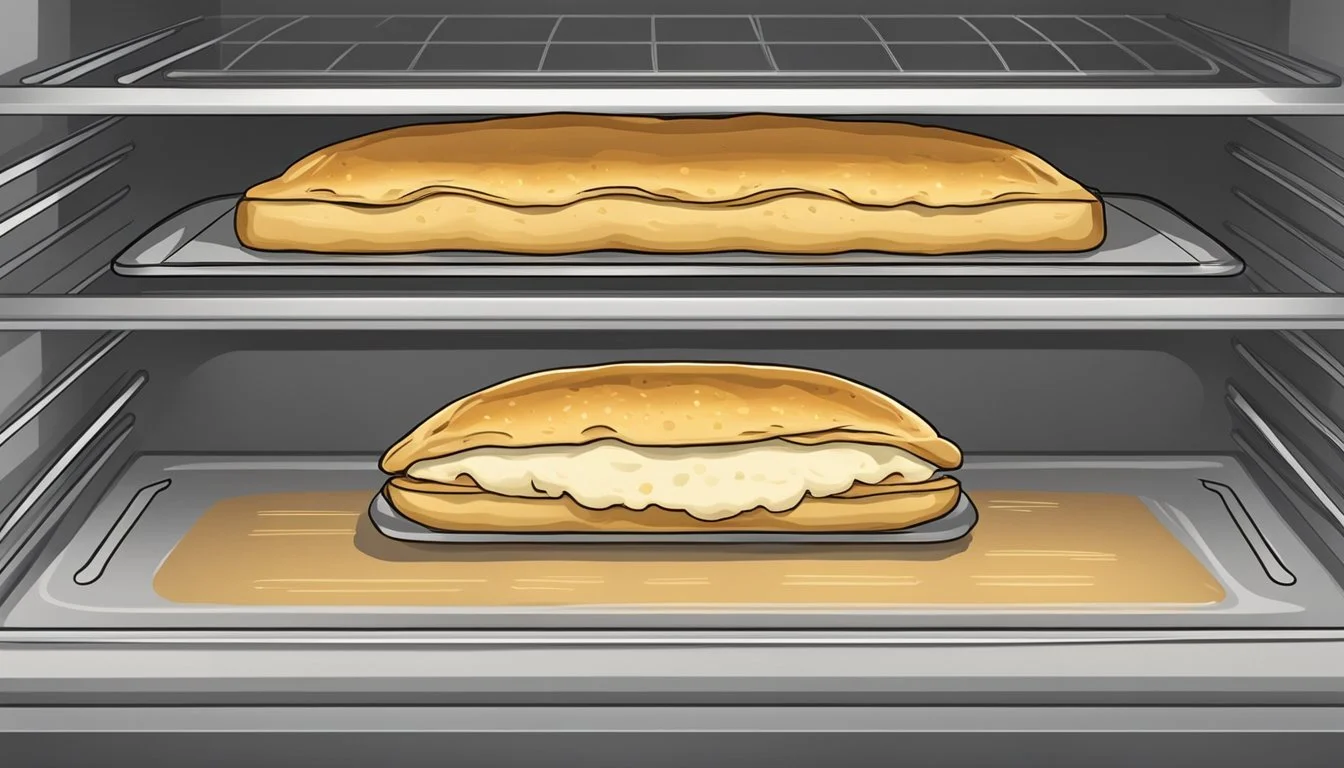How Long Do Chicken Hot Pockets Last?
Storage Tips and Shelf Life
Chicken Hot Pockets are a convenient option for a quick meal on the go. Created by Paul and David Merage and now produced by Nestle, these frozen snacks have become a household staple. Stored in the freezer, Chicken Hot Pockets can last up to 14 months from the manufacturing date. This makes them an excellent choice for stocking up without concern for rapid expiration.
To ensure the best quality and safety, it's crucial to keep Hot Pockets properly stored. If left in the refrigerator, they should be consumed within three to four days due to their meat and dairy content. Improper storage can lead to spoilage and potential foodborne illnesses, so adhering to recommended guidelines is essential.
For those looking to enjoy their Hot Pockets at their best, consuming them within a few months of purchase is recommended. Even though they have a lengthy shelf life, the taste and texture may decline the longer they remain frozen. By following these simple storage tips, you can enjoy your Chicken Hot Pockets safely and deliciously.
Understanding Hot Pockets
Hot Pockets have become a popular quick meal or snack, steam-cooking fillings encased in dough. They boast a vibrant history, assorted flavors, and signature ingredients.
History and Origin
Hot Pockets were introduced by Paul and David Merage in 1983. Initially marketed as Tastywich, they were rebranded after launching in 1981 and quickly gained popularity. Nestlé acquired the brand in 2002, further cementing its market presence. The inspiration behind this product was to offer a convenient, savory snack that could be heated quickly. Over time, they became a household name synonymous with microwaveable convenience foods.
Variety of Flavors
Hot Pockets come in a range of flavors, catering to diverse culinary tastes. Classic options include Pepperoni Pizza and Ham & Cheese. Vegetarian options feature fillings like spinach and artichoke. The crust types also vary, from crispy to flaky or seasoned crusts. Seasonal and limited editions often introduce new, innovative fillings to keep the product line fresh and exciting.
Key Ingredients
The primary ingredients in Hot Pockets include dough, meats, cheeses, and vegetables. The dough is designed to crisp up in the microwave or oven, providing a satisfying texture. Cheeses like mozzarella and cheddar are staples. Meats such as pepperoni, sausage, and chicken are commonly used. Additionally, various veggies enhance the flavor and nutritional value. Additives and preservatives help maintain shelf life and quality, making Hot Pockets a reliable choice for quick meals.
Storage Guidelines
Proper storage of chicken hot pockets can ensure their quality, taste, and safety. Key considerations include storing them in the freezer, using the fridge correctly, and understanding the expiration dates.
Freezer Storage
Chicken hot pockets are best stored in the freezer, as it significantly extends their shelf life. When kept at 0°F (-18°C) or lower, they can last for several months without losing quality. It's essential to keep the hot pockets in their original packaging or in an airtight container to prevent freezer burn.
Freezing chicken hot pockets immediately after purchase helps maintain their taste and texture. Labeling them with the purchase date can help track how long they've been stored. Consuming them within the manufacturer's recommended time frame ensures the best quality.
Refrigerator Storage
If you choose to store chicken hot pockets in the fridge, it's critical to do so correctly. They should be eaten within 2 to 3 days to maintain quality and safety. The fridge should be set at 40°F (4°C) or lower to slow bacterial growth.
Keeping them in their original packaging or in an airtight container helps keep them moist and flavorful. It's also important to ensure the fridge maintains a consistent temperature. Never leave them on the counter for extended periods, as it can lead to bacterial growth.
Understanding Expiration Dates
Understanding expiration dates is crucial for both safety and quality. The expiration date on the packaging indicates the last date a product is expected to be at peak quality. After this date, taste and texture may diminish, though it may still be safe to eat if stored properly.
Checking the “use by” or “best by” date on your chicken hot pockets can guide how long they will remain flavorful and safe. Once hot pockets are thawed, they should be consumed promptly and not refrozen. Always follow the manufacturer's storage recommendations to ensure the safest consumption.
Preparation Methods
Cooking chicken hot pockets is straightforward, but the method chosen can greatly affect the final result. Below are detailed instructions for using a microwave, oven, air fryer, toaster, and toaster oven.
Microwave Cooking
Microwave cooking is the quickest method for preparing chicken hot pockets. Remove the hot pocket from its packaging and place it inside the provided crisping sleeve. Put the hot pocket on a microwave-safe plate.
Set the microwave on high for about 2-3 minutes, depending on the microwave's wattage. Cooking times may vary, so checking for a hot center by probing with a fork can confirm doneness. If more time is needed, continue cooking in 30-second increments until the center is hot and the outside is crispy.
Oven Baking
Using the oven ensures an evenly heated and crispy crust. Preheat the oven to 350°F and remove all packaging materials from the hot pocket. Place the hot pocket on a baking sheet.
Bake for 20-25 minutes or until the internal temperature reaches 165°F. For different styles like the 'Big & Bold' hot pockets, additional time may be needed. Monitor the cooking closely to avoid over-baking.
Using an Air Fryer
An air fryer offers an efficient way to cook hot pockets with minimal fuss. Preheat the air fryer to 360°F and unwrap the hot pocket. Place the hot pocket in the air fryer basket, ensuring they are not overlapped.
Cook for 10-12 minutes, turning halfway through to ensure even cooking. This method requires less time than traditional ovens and delivers a crispy, golden-brown finish. Avoid using a crisping sleeve in the air fryer.
Toaster and Toaster Oven Tips
A toaster or toaster oven provides an alternative for those without a full-sized oven. Unwrap the hot pocket and place it directly on the toaster oven rack. If using a toaster oven, preheat to 350°F and set to bake.
Cook for 20-25 minutes, checking periodically for desired doneness. Avoid the crisping sleeve and ensure even cooking by turning the hot pocket halfway if necessary. Using a baking sheet helps catch any drips and makes cleanup easy.
Maintaining Quality and Safety
When storing Chicken Hot Pockets, it is essential to maintain their quality and ensure they remain safe to eat. Following best practices for identifying spoilage, preventing freezer burn, and correctly reheating can help avoid foodborne illnesses.
Identifying Spoilage
Chicken Hot Pockets can spoil if not stored properly. Signs of spoilage include discoloration, a foul odor, and visible mold. A safe, unspoiled Hot Pocket should maintain its original color, without any green or grayish spots.
Bacteria Growth: If kept in the refrigerator for too long, bacteria may grow, leading to foodborne illnesses. Consuming spoiled Hot Pockets can result in food poisoning, so it's crucial to check for any unusual signs before reheating.
Preventing Freezer Burn
Freezer burn affects the texture and taste of Chicken Hot Pockets. It occurs when food is exposed to air in the freezer, causing dehydration and ice crystals. To prevent freezer burn, wrap the Hot Pockets tightly in aluminum foil or store them in airtight freezer bags.
Proper Packaging: Using a crisper sleeve or resealable bag can further protect them. Labeling and dating the packages can help ensure they are used within optimal storage times, typically up to 2-3 months to maintain best quality.
Reheating and Consumption
Proper reheating is vital for both safety and quality. Always follow the package instructions, using a microwave or conventional oven. For microwaving, use the provided crisper sleeve to ensure an even, crispy texture.
Reheat Safe to Eat: The internal temperature should reach 165°F (74°C) to ensure they are safe to eat. Avoid reheating multiple times as it can degrade quality, causing dry texture and affecting taste.
Consumption Timing: It is best to consume reheated Hot Pockets immediately. If they are cooled and reheated again, it increases the risk of spoilage and loss of quality. Avoid refreezing thawed Hot Pockets to maintain their original taste and texture.
Nutritional Considerations
When considering the nutritional aspects of chicken Hot Pockets, it is important to be aware of both their caloric and sodium content and potential healthier eating choices that can be made. This understanding helps to make informed dietary choices.
Caloric and Sodium Content
Chicken Hot Pockets are known for their convenience, but they come with a high caloric and sodium content. A single serving typically contains around 270-300 calories, which includes a significant amount of saturated fats and carbohydrates. These calories can quickly add up, especially if multiple servings are consumed.
In terms of sodium, each Hot Pocket can contain between 600-900 milligrams. High sodium intake can contribute to hypertension and other cardiovascular issues. Given many dietary guidelines suggest a daily sodium limit of 2,300 mg, consuming multiple Hot Pockets can quickly approach or exceed this limit.
Healthier Eating Choices
For those looking to make healthier eating choices, it might be helpful to consider alternatives to traditional Hot Pockets or modifications that can be made. Opting for whole grain or low-fat versions can significantly decrease both caloric and sodium content.
Adding a side of fresh vegetables or a salad can balance the meal, providing fiber and essential nutrients. Additionally, making homemade versions allows for better control over ingredients, potentially reducing unhealthy components like excess sodium and saturated fats.
Another strategy involves checking labels closely and choosing options with fewer preservatives and artificial additives. This can contribute to a healthier overall diet and help mitigate potential negative health impacts.
Product Variations and Innovations
Hot Pockets have undergone various changes and updates since they were first introduced, including the introduction of limited editions and changes in packaging and sizes to meet consumer preferences.
Limited Editions and Discontinued Products
Over the years, Hot Pockets has experimented with several limited edition flavors and special products. These variations often focus on unique combinations or seasonal ingredients to attract new customers.
For instance, special editions like Buffalo Chicken or Philly Cheesesteak have seen popularity spikes. Despite their initial success, these flavors are often discontinued after the promotional period. Discontinued products might resurface if there's enough consumer demand.
These limited-time offerings allow the brand to test new concepts and gather feedback, providing valuable insights for future product development.
Multiple Packaging and Sizes
Hot Pockets are available in various packaging and size options. Popular choices include standard two-packs and family-size packs designed for multiple members.
This variety helps consumers choose the right amount based on their needs—single servings for individuals or larger packs for families.
Packaging has also evolved to include eco-friendlier options, minimizing the environmental impact. Additionally, multipacks are offered in bulk stores, appealing to cost-conscious shoppers looking for value deals.
The diversity in packaging ensures the product meets a wide range of consumer demands efficiently.
Cooking Tips and Tricks
For a perfectly cooked Chicken Hot Pocket, certain tips and tricks can enhance the texture, avoid overcooking, and achieve an even crispy crust.
Avoiding Common Mistakes
To avoid a soggy Chicken Hot Pocket, ensure it is properly defrosted before cooking. If using a microwave, set it to defrost mode for a minute. Avoid overheating by not exceeding the recommended cooking time.
Microwaves can cook unevenly, so let the Hot Pocket sit for a couple of minutes after microwaving. This allows the heat to distribute evenly. Always check the internal temperature. It should be at least 165°F to ensure it's cooked through.
When using an oven, preheat it to 350°F for balanced cooking. Placing the Hot Pocket directly on the oven rack instead of a baking sheet can also help achieve a more even cook.
Achieving the Perfect Crispy Crust
To achieve a crispy crust, avoid using the crisping sleeve in the microwave. Instead, cook the Hot Pocket for a minute less than recommended and finish it off in a preheated oven or air fryer for a few minutes.
In an oven, placing the Hot Pocket on an elevated wire rack can facilitate air circulation and contribute to a crispier crust. Cooking it at 350°F for about 20-25 minutes and flipping it halfway through ensures even browning.
For air fryer enthusiasts, a preheat of 350-400°F, followed by 10-12 minutes of cooking, yields a crispy texture. Remember to check every few minutes to avoid overcooking.
Consumer Insights
Analyzing consumer behavior provides valuable insights into purchase decisions and their impact on customer loyalty and feedback.
Purchase Decisions
Consumers consider several factors before purchasing chicken Hot Pockets. Expiration dates play a crucial role, with Hot Pockets typically having an expiry date 14 months after manufacturing. Freshness is paramount, and buyers often choose products based on how close they are to this date.
Storage recommendations also influence purchasing decisions. Buyers are aware that Hot Pockets can last up to three months in the freezer and up to 2-3 days in the refrigerator for optimal taste and quality. Convenience is key, so easy-to-follow cooking instructions and fast preparation times (2-3 minutes in the microwave) are appealing.
Price and availability also affect purchases. Promotions and discounts can sway decisions, especially for frequent shoppers. Retailers must ensure consistent stock levels to meet demand, as stockouts may lead to shoppers switching brands.
Customer Loyalty and Feedback
Customer loyalty for chicken Hot Pockets hinges on consistent quality and taste. Positive experiences lead to repeat purchases, as consumers trust the product's reliability. Feedback mechanisms, such as surveys and social media interactions, allow brands to gather insights and address issues promptly.
Common feedback includes taste preference, portion sizes, and packaging. Consumers generally favor convenient and resealable packaging that preserves freshness. Controlling quality and addressing issues, such as inconsistent filling or overcooked edges, directly impacts customer retention.
Engaging with loyal customers through rewards programs or exclusive offers can enhance brand loyalty. Responding to feedback, adapting to consumer needs, and maintaining high standards fosters long-term customer relationships.









